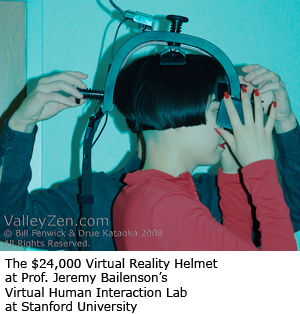How to Become Who You Want to Be – Stanford’s Virtual Reality

Prof. Jeremy Bailenson is turning heads (real and virtual). With all the media attention he has received lately for his research at Stanford’s Virtual Human Interaction Lab (VHIL), you might suspect he was making use of multiple avatars to sit in for all these interviews.
The New York Times, Newsweek, The Wall Street Journal, The Chronicle of Higher Education, Science Magazine, and The TODAY show have got Prof. Bailenson in the media spotlight right now.
Today TIME magazine features VHIL. The story hit CNN’s home page, too. Check it out HERE. Moments ago, Drue interviewed Prof. Bailenson (the real one!) via phone for ValleyZen about Zen’s intersection with Virtual Reality (VR) as he biked home from his lab.
VIRTUAL SELF — ZEN SELF
“For me, Zen is about becoming the person that you want to be. An avatar is an ideal that can help you visualize an ideal self. It can act as a bridge between the actual self and the optimal self,” said Bailenson. For example, some of his current research is about how the way a person acts in Virtual Reality can translate over into real life. “If you exercise your avatar in VR, you’ll behave healthier in real life,” says Bailenson.
VIRTUAL REALITY in EMPTY SPACE
I’ve had the opportunity to don the $24,000 VR helmet and step into one of Prof. Bailenson’s simulations. It struck me that the room I was in was a Zen void, a huge empty white cube. Yet with the helmet and the VR, the space was full. I asked Prof. Bailenson for his thoughts on VR and empty space. “VR is infinite visual space in zero physical space,” he said.
ZEN SIMPLICITY in VIRTUAL REALITY
I asked Prof. Bailenson about how Zen’s emphasis on eliminating and subtracting to achieve simplicity relates to VR. He responded, "When we create an avatar, we are freeing ourselves from all constraints, and all the physical things in real life that populate our everyday existence. In virtual space we have a self that exists without the physical crutches you rely on normally."
NOTHINGNESS
I was reflecting on Shunryu Suzuki’s words, "Exhale into emptiness…You are actually aiming at emptiness." Bailenson and I had a fun nothingness VR ideation jam session. He paused—
“NO Age. NO Gender. NO Color. NO Race. A Simple NON-shape, it’s timeless…Imagine an avatar like that.”
“I like the idea of removing so many elements we consider essential to self and seeing where it takes you,” I said.
“The self could be just a cube. How does one behave later on in the physical world after spending so much time with an avatar that has no features. You are in effect distilling the essence,” said Bailenson.
“Yes,” I said.
“Like a Sensory deprivation tank!” he said
“How interesting,” I said, “Is this an experiment you’ve run.”
“No,” he said, “You’re giving me research ideas!”
VALLEYZEN VIDEO INTERVIEW Coming in June
ValleyZen will be doing an ultra-cool video interview with Jeremy so stay tuned for that.



I never thought of an avatar as a device to be used in Spring cleaning the brain and spirit but Prof. Bailenson makes a strong case for its vacuuming capacity.